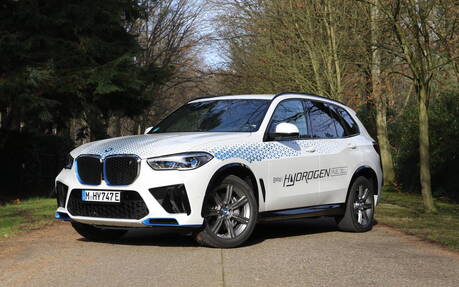BMW iX5 Hydrogen: Behind the Wheel of a Pioneer
Antwerp, Belgium—With the progressive elimination of internal combustion engines, automakers are massively turning to battery electric vehicles, while a small number want to keep the fuel cell dream alive. In fact, some are working on both technologies at the same time.
The list includes Toyota, Hyundai, Honda and BMW, which is experimenting with a brand new SUV called iX5 Hydrogen. A fleet of under 100 vehicles will be employed internationally for demonstration and trial purposes for various target groups, with the German automaker hoping to start sales in the medium term.
- Also: BMW to Use Canadian-Made Aluminum in SUVs Starting in 2024
- Also: 2024 BMW X5, X6 Get Fresh Styling, More Power, Longer EV Range
Hydrogen 101
We won’t go into the specifics of how a fuel cell works. All you need to know is that hydrogen is combined with oxygen in a fuel cell that houses platinum-covered electrodes. The chemical reaction produces electricity, heat and water.
In order to achieve decent enough range, hydrogen must be compressed inside a high-pressure tank. In the case of the BMW iX5 Hydrogen, it is stored in two 700-bar (10,150-psi) tanks made of carbon-fibre reinforced plastic (CFRP). Together these hold almost 6 kg of hydrogen, enough to give the vehicle a range of 504 km in the WLTP cycle.
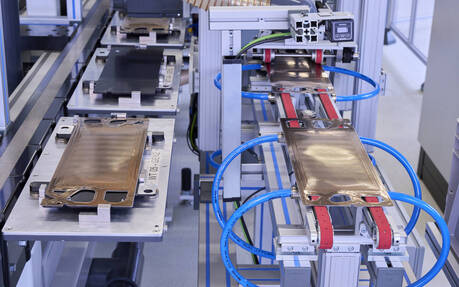
Since pressure inside the tanks is too high to feed hydrogen directly into the fuel cell, a regulator brings it down to 10-15 bars (145-215 psi) as a first step, and another system further lowers the pressure to around 1 bar (14.5 psi) when hydrogen enters the fuel cell.
On the other side, a system filters outside air and channels it into a compressor to essentially match the hydrogen pressure. Air is then cooled before it gets injected into the fuel cell.
Electricity generated by the hydrogen-oxygen mixture can be used to drive the motor or stored in a small battery. The iX5 Hydrogen has a 2kWh battery, which is nowhere near the capacity of a typical battery electric vehicle.

Heat produced by the fuel cell can go as high as 90° Celsius. Most of it is used to keep the cabin warm and preserve range. As for water, which is the third byproduct of the chemical reaction inside the fuel cell, it is sent through a dedicated exhaust system with noise reducer. BMW says the iX5 Hydrogen emits 10.8 L of water per 100 km.
The Drive
Based on the plug-in hybrid variant of the BMW X5, the new iX5 Hydrogen is marginally lighter. While the exact weight is not specified, we know that the X5 xDrive45e tips the scales at 2,561 kg, so it’s still pretty heavy. The chassis has been slightly modified, but the tires are the same. The two models look very much alike, too, with just blue accents setting the iX5 apart inside and out.
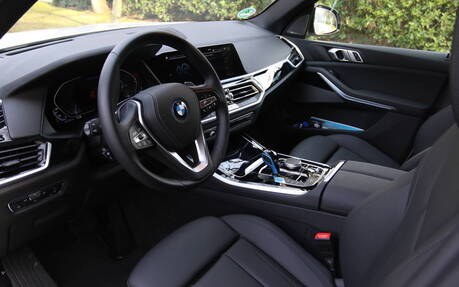
The electric motor and the transmission both come from the all-electric BMW iX. The pilot vehicles will all feature rear-wheel drive, although BMW says a second motor driving the front axle could be added at some point to create an AWD setup.
So, how’s the drive? Exactly like an electric SUV at first, to be honest, while handling feels more like that of a gasoline-burning X5—surprisingly sharp and nimble for a vehicle of this size and weight. Total system output is rated at 396 hp, which is ample enough.
Acceleration is brisk (0-100 km/h in just under six seconds) but does not quite match the explosiveness of the iX. The fuel cell makes a bit of noise when you stand next to the vehicle, but once you’re driving you no longer hear it. As a matter of fact, the iX5 Hydrogen is just as silent as any battery electric vehicle. The regenerative braking system proves just as effective, capturing and storing energy in the battery for those times when more power is required.
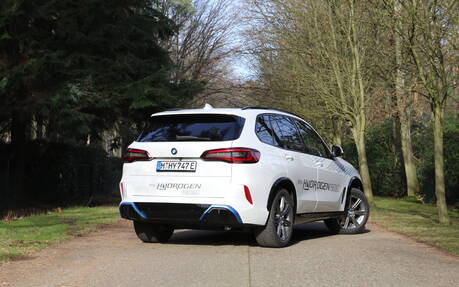
For our two-hour test drive, the iX5 Hydrogen averaged 1.4 kg of hydrogen per 100 km. Remember, the tanks can hold almost 6 kg of hydrogen, which means we could have traveled about 430 km. We stopped by a hydrogen refueling station so BMW could show us how to fill those tanks. Other than locking the nozzle and pressing a button (green or red) to start or stop the operation, it was pretty much like a visit at a regular gas station. Four minutes and we were done.
The Future of Hydrogen in Canada
Driving a fuel cell vehicle is very similar to driving a battery electric vehicle, except that filling the hydrogen tanks is way shorter than charging a battery, even when using a DC fast charger.
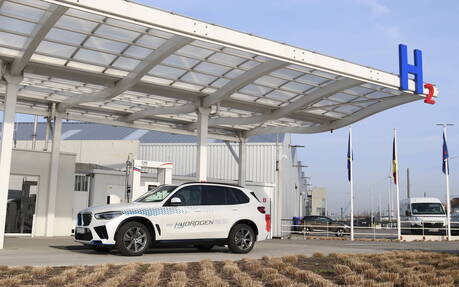
There are a number of drawbacks, however. First, only a handful of hydrogen refueling stations (literally, just five) are open to the public in B.C., with one more in Quebec. Second, producing ready-to-use hydrogen comes with tremendous costs and energy demands.
Fuel cells and hydrogen tanks, which are the most expensive components on the vehicle, also have a lifespan. As BMW told us, European laws require tanks to be replaced after 15 years even though they could theoretically last longer than that. As for replacing fuel cells, we couldn’t get a solid answer from the German automaker, other than saying they should achieve about the same mileage as a conventional engine.

Does fuel cell technology have a future in Canada? Most definitely yes, but not for light-duty vehicles like the majority of people drive. Rolling out refueling stations all across the country at several million dollars apiece doesn’t sound like a great idea.
On the other hand, heavy-duty trucks and commercial vehicles are prime candidates to receive the technology, which would maximize range and limit downtime versus EV batteries, especially in cold weather. These trucks could be well served by a network of strategically located stations.
For the record, BMW has no plans to replace battery electric vehicles with fuel cell vehicles. All the experts we talked to insisted on the fact that the latter represent an alternative solution, like another piece of the puzzle. Every country around the globe is different in terms of population density and mobility needs. Germany (along with most of Europe) and Japan are places where hydrogen technology is more likely to succeed.
